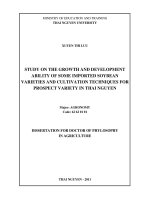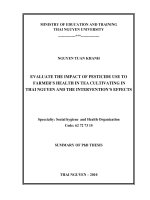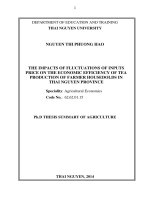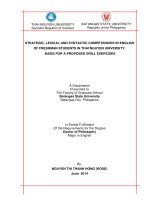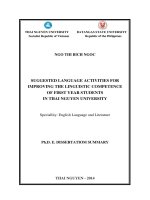abstract of dissertotation doctor of basiness administrationevaluating the implementation of umemployment insurance in thai nguyen province
Bạn đang xem bản rút gọn của tài liệu. Xem và tải ngay bản đầy đủ của tài liệu tại đây (194.29 KB, 23 trang )
Thai Nguyen University
Socialist Republic of Vietnam
Southern Luzon State University
Republic of Philippines
EVALUATING THE IMPLEMENTATION
OF UNEMPLOYMENT INSURANCE
IN THAI NGUYEN PROVINCE
ABSTRACT OF DISSERTATION
DOCTOR OF BUSINESS ADMINISTRATION
BY
PHUNG THI CAM CHAU – ROSE
August, 2013
The thesis was completed at:
Thai Nguyen University
Supervisor: Assoc Prof Dr Do Anh Tai
Reviewer 1:
Reviewer 2:
The dissertation will be defended in the thesis evaluation council at:
Southern Luzon State
University
, Philippines
At ……………………
The thesis can be found in the materials center of Thai Nguyen University
And the library of Southern Luzon State University, Philippines
1
CHAPTER I
INTRODUCTION
Unemployment insurance is the process of formation and use
of funds through the financial contributions of the employee, the
employer and the help of the state, in order to support of income for
workers in period they have lost their jobs, enabling them to find new
jobs in the labor market. This has important implications for
individual workers and companies, contributing to balancing role in
the economy, helping to decrease social stress caused by
unemployment. That is one of the tools to implement social security
policies of each country.
In Vietnam, unemployment insurance, as a mode of social
insurance and a component of social security, has been built and was
officially implemented in 2009.
BACKGROUND OF THE STUDY
4-year experience, the implementation of unemployment
insurance has made significant achievements, but also has some
limitations that should soon be adjustments to this policy performs its
role in a better way.
As a law lecturer with passion for researching and teaching
law of labor and social security, also derived from the responsibility
of a person was born and raised in the land of Thai Nguyen, the
authors decided to select the topic "Evaluating the implementation of
unemployment insurance in Thai Nguyen province" for her research.
STATEMENT OF THE PROBLEM
The main purpose of this study are evaluating the
implementation of unemployment insurance in Thai Nguyen
2
province in 2012 and propose some recommendations to improve the
implementation of the policy in the coming years.
In solving the research problem mentioned previously, this study
has the following objectives:
1. To describe the characteristics of the respondents.
2. To determine the perception of the respondents on the
implementation of UI in terms of: Coverage of UI; Conditions for the
enjoyment of UI; UI fund; UI regimes; Procedures for UI regimes.
3. To compare the perceived implementation of the UI when
the respondents are grouped in terms of: Type of unit that employees
had worked before unemployment.
4. To propose some recommendations to improve the
implementation of unemployment insurance in Thai Nguyen
province in the coming years.
Specifically, it sought answers to the following questions:
1. What is the profile of the respondents in terms of: Age;
Sex; Type of unit that employees had worked before unemployment;
Type of labor contract/ work contract had been signed before
unemployment; Current job status; Time has participated in UI; UI
enjoy status.
2. What is the perception of respondents on the
unemployment insurance in Thai Nguyen province in terms of:
Coverage of UI; Conditions for the enjoyment of UI; UI fund; UI
regimes; Procedures for UI regimes.
3. Is there significant difference between the perception of the
employees are grouped in terms of type of unit that employees had worked
before unemployment (who were entitled to unemployment insurance in
3
2012) on the implementation of unemployment insurance in Thai Nguyen
province?
4. What would be the proposed recommendations to improve
the implementation of unemployment insurance in Thai Nguyen
province in the coming years?
SIGNIFICANCE OF THE STUDY
This study would be beneficial to employees, trade unions in
enterprises, enterprises, the unemployment insurance policies
promulgate agencies and the unemployment insurance management
agencies, researcher and future researchers.
SCOPE AND LIMITATIONS
The primary intent of this study is to evaluate the
implementation of unemployment insurance in Thai Nguyen
province in 2012. There were 348 employees who were entitled to
unemployment insurance in Thai Nguyen province used as
respondents in this study.
Measurement of the implementation of unemployment
insurance in Thai Nguyen province is limited to the use of
questionnaires with a limited number of involved people. Checklist is
developed for the purpose of the study.
The time frame of this study covered the period from January
2012 to April 2013.
DEFINITION OF TERMS
The terms are defined to include: A definite term labor
contract, a labor contract, a working contract, an employee, an
employer, an indefinite term labor contract, service unit of the
4
State, large enterprise, Small and medium enterprise, social
insurance, the labor force, the social insurance organization, the
unemployed, the unemployment rate, trade Union, unemployment
insurance.
CHAPTER II
REVIEW OF RELATED LITERATURE AND STUDIES
This chapter presents the discussion of topics that served as
background information in conducting this study.
REVIEW OF RELATED LITERATURE
After presenting an overview of unemployment insurance:
concepts, characteristics, roles and implementation unemployment
insurance career agencies, the authors focus on presenting material
related law provisions of the basic unemployment insurance contents
and the enforcement of such regulations. There are five basic
contents: coverage of unemployment insurance; conditions for the
enjoyment of unemployment insurance; unemployment insurance
fund; unemployment insurance regimes; procedures for
unemployment insurance regimes.
REVIEW OF RELATED STUDIES
Unemployment insurance was first defined in the Social
Insurance Law of 2006, takes effect in 2009. Due to the new policy
should also present, there is not much research on this issue.
CONCEPTUAL FRAMEWORK
The conceptual model includes three parts: Input, process
and output.
5
INPUT PROCESS OUTPUT
- The profile of the
respondents in terms
of: Age; Sex; Type of
unit that employees had
worked before
unemployment; Type
of labor contract/ work
contract had been
signed before
unemployment;
Current job status;
Time has participated
in UI; UI enjoy status.
- The respondents’
perception on
implementation of UI
in Thai Nguyen
province in terms of:
coverage of UI;
conditions for the
enjoyment of UI; UI
fund; UI regimes;
procedures for UI
regimes.
- Data
gathering
- Evaluation
through
questionnaire
checklist
- Analysis and
interpretation
of data
The proposed
recommendation
s to improve the
implementation
of UI in Thai
Nguyen province
in the coming
years
FEEDBACK
6
CHAPTER III
METHODOLOGY
This chapter deals with the locale of the study, research design,
population and sampling, instrumentation, data gathering procedures,
and statistical treatment used in the study.
LOCALE OF THE STUDY
This study focuses on assessing the implementation of
unemployment insurance through respondents in Thai Nguyen
province.
RESEARCH DESIGN
In this study, the researcher basically uses the descriptive
method which is appropriate for evaluating the implementation of
unemployment insurance in Thai Nguyen province.
POPULATION AND SAMPLING
In 2012, in Thai Nguyen province, there were 2,665
employees entitled unemployment insurance.
To determine the ideal sample size for a population, Slovin's
formula is used. So, 348 employees are entitled to unemployment
insurance in 2012 (out of 2,665 employees) were selected to answer the
questionnaire. This research used probability-sampling method.
Simple random sampling was chosen in this study.
RESEARCH INSTRUMENTATION
The researcher creates a questionnaire which was the main
tool in gathering data. A questionnaire is divided into two parts. The
first part determined the profile of the respondents; the second part
determined the perception of the respondents on implementation of
unemployment insurance in Thai Nguyen province. There were 30
questions (with weighted scale: (5) very good, (4) good, (3) fair, (2)
7
weak, (1) bad) which divided into 5 groups of issues: Coverage of
unemployment insurance, conditions for the enjoyment of
unemployment insurance; unemployment insurance fund,
unemployment insurance regimes and procedures for unemployment
insurance regimes
VALIDATION OF THE INSTRUMENT
A validation of the questionnaire is done using the inter-
consistency judgment criteria. The researcher sought the assistance
of some experts to validate the content of the questionnaire in terms
of correctness of language, appropriateness of the statements and
relevance of the items to the problem using the codes: 3 for
“acceptable”, 2 for “needs revisions”, and 1 for “not acceptable.”
DATA GATHERING PROCEDURE
The actual data gathering procedures was done through
several processes: Making a research proposal and a research
planning, collecting materials theory, finding reports about the
implementation of unemployment insurance in Thai Nguyen
province, determining sample, building questionnaire, survey.
DATA PROCESSING METHOD
This study used the ratios: coverage of unemployment
insurance, conditions for the enjoyment of unemployment insurance,
unemployment insurance fund, unemployment insurance regimes,
procedures for unemployment insurance regimes as dependent variables,
and, the implementation of UI as the independent variables. These ratios are
derived from unemployment insurance statements. SPSS and Excel software
will help this data transformation easily and quickly.
8
STATISTICAL TREATMENT
To answer the problems posed in this study, the following
statistical tools were applied on the data collected:
To determine the profile of the respondents, mean, frequency
and percent distribution and standard deviation analysis were used as
a descriptive statistics.
In order to evaluate the implementation of unemployment
insurance in Thai Nguyen province, weighted mean was utilized. For
further interpretation, the 5 – point scale ((5) very good, (4) good, (3)
fair, (2) weak, (1) bad) was used.
To find out if there is a significant difference on the
perceptions of the respondents regarding the implementation of
unemployment insurance in Thai Nguyen province, analysis of
variance (ANOVA) was used.
CHAPTER IV
PRESENTATION, ANALYSIS AND INTERPRETATION OF DATA
This chapter presents the analysis and interpretation of data
gathered that would answer the problems stated in the previous
chapter. The data and statistical findings are presented and given
implications to concretize the concepts.
PROFILE OF RESPONDENTS
In 2012, in Thai Nguyen province, 2665 people have signed
up and were decided to unemployment insurance regimes. 348
employees of them have been selected as respondents of the
questionnaire. This section presents statistics and analyses of profile
of the respondents according to the criteria: age, sex, types of units
that worked before unemployment, type of labor contract/ work
9
contract had been signed before the unemployment, salary
(according to the labor contract/ work contract) before the
unemployment, current job status, duration has participated in
unemployment insurance, times entitled to unemployment insurance
THE IMPLEMENTATTON OF UNEMPLOYMENT
INSURANCE IN THAI NGUYEN PROVINCE
This section analyzes, explains, comments on the
outstanding issues, finds out the difference in the perception and
evaluation of the three groups of respondents in the subject matters
of unemployment insurance.
Synthesis of the results, we see that, in the assesment of the
respondents, the implementation of unemployment insurance in Thai
Nguyen province is not really good.
We also can see the difference in the perception and
evaluation of the three groups of respondents in the subject matter of
the unemployment insurance.
Among three groups of respondents, employees in service
units of the State always understand, evaluate and implement
unemployment insurance in a more positive level, employees in large
enterprises assess issues lower threads and employees in small and
medium enterprises evaluate lower level. However, the overall result is
often "proximity" with the results of the group of employees in small
and medium enterprises, because they account for the high rate of
unemployment, and a high proportion of this survey.
Those differences shown in the analysis of variances results.
The differences in the assessment of this issue can be
explained by several reasons. First, the law has recognized the right
to participate and receive UI for most employees in service units of
10
the state, but they "missed" a lot of people working in business,
especially small enterprises, use less of labor, duration of labor
contracts are short, Besides, the propagation of labor legislation,
including UI policy, in services units of the state has always been
more focused, employees in this type of unit have better knowledge
(because of job requirements). The contribution to the UI fund and
UI regimes, although the law does not make any distinction between
workers belonging to different groups, but the implementation is
very different between three groups of employers (of three groups of
respondents). The procedures for UI regimes for all workers are the
same, but the implementation is affected quite largely by the
responsibility of the employers, but this is different between the three
groups of employers. From here, we can also see that, in the
implementation of UI policy, there are many things that businesses,
especially small and medium enterprises, should learn the service
units of the State.
CHAPTER V
SUMMARY, FINDINGS, CONCLUSIONS AND
RECOMMENDATION
The findings, conclusions and recommendations to improve
the effectiveness of unemployment insurance policy in Thai Nguyen
province are being presented in this chapter.
SUMMARY OF THE FINDINGS
Characteristics of the respondents
There were 348 employees who were entitled to UI in Thai
Nguyen province in 2012 (out of 2,665 employees) were selected to
answer the questionnaire.
11
Regarding age, the majority of the unemployed are under the
age of 40 (up 264 people, 348 people in total, corresponding to
75.86%), which, with 162 people under 30 years old (up 46.55%),
102 from 30 to 40 years old (up 29.31%). Meanwhile, unemployed
people aged 40-50 and especially not more than 50 years of age (54
and 30 respectively, accounting for 8.62% and 15.52%).
Regarding gender, unemployed workers are men in this
survey are somewhat more than women (197 men, accounting for
56.61% and 151 women, representing 43.39%).
According to the type of unit, the employees participating in
the survey the majority of previous work in the business (341 of 348
respondents), the majority of them work for small and medium
businesses (306 people). Meanwhile, there are few unemployed
people from the business units of the state (7 people, accounting
2:01%).
Regarding labor contract/ work contract, 134 of the 348
respondents who were working under an indefinite term labor
contract (up 38.51%), 214 people have been working under definite
contract for 12 - 36 months (up 61.49%), no one working under
contract for less than 12 months.
Regarding wages, more than half of the workers interviewed
had previous average wage in paragraphs 2-5 million dongs/ month.
People with low wages (less than 2 million dongs/ month) and
passable (from 5-10 million dongs/ month) accounted for less than
73 people, respectively, accounting for 20.98% and 63, accounting
for 18.1%. Not many workers have previous salary of 10 million
dongs (15 people, representing 4.31%).
12
In the current work status, the majority of workers were
unemployed in 2012 had a job interview (320/348, accounting for
91.95%), only a small number of workers still do not have the refresh
(38/348, accounting 8.05%). A significant amount of workers has
been searching for a job with better salary (125 people, accounting
for 35.92%).
Regarding duration of UI participation, none of the
respondents have less than 12 months this time. The UI from 12
months to 24 months is 208, accounting for 59.77%, the UI over 24
months is 140, accounting for 40.23%.
Regarding the time of beneficiaries of UI policy, the
majority of respondents were entitled one times (335/348, accounting
for 96.26%), only 11 of the respondents were entitled 2 times (up
3.16%) and 2 people benefit more than 2 times (up 0.58%).
The perception of the respondents on the implementation
of unemployment insurance
In terms of the coverage of UI, awareness of the object of the
UI is different workers in the period before the insured after
unemployment and participation, enjoyment mode of UI. Knowledge
workers may be partly because the research efforts them, but depend
significantly to the dissemination of the agencies, organizations and
individuals are responsible for propagating policies to them.
According to the employees, the employers did not meet the
performance needs to provide information about UI for them, the
organization of social insurance to provide information about UI is
the interview assessment level rather than in general has not been
good. Businesses, labor offices, social insurance organizations are
the responsible agencies for policy advocacy UI to workers did not
13
meet expectations of workers on the information about this policy.
This is a part of the reasons of situation: the employee very poor
grasp of UI policy.
On the status of current UI policy only cover required
participants, not voluntary participants, the majority of respondents
found that this is a limitation of the current UI program. Social
insurance policy and health insurance is designed program of
compulsory insurance and voluntary groups for different levels of
contribution and different respective beneficiaries, UI not do this.
The provision to employees working under labor contract or
work contract with a term of not less than 12 months of UI, the
majority of respondents did not agree.
In terms of conditions for the enjoyment of UI, understanding
of respondents is generally not good, especially before their
participating in this policy. Overall, the evaluation of the respondents
on condition for enjoy UI is only at fair and weak level. It is quite
similar to the level of awareness of participants about UI.
Employees generally dissatisfied with regulation: an
unemployed persons are entitled to UI when they satisfy the
condition: “Having paid UI premiums for full 12 months or more
within 24 months before they become unemployed”, especially those
who in the service units of the state, who have the best understanding
of the UI policy. This means that this is an unreasonable point of
current UI policy.
In terms of UI fund, the respondents all said that regulation:
“Laborers' payment of 1% of the monthly salary or remuneration on
which UI premiums are based” is well defined, and they themselves
made contributions for UI fund is good. Meanwhile, most of them
14
assessed regulation: “Employers' payment of 1% of the fund of
monthly salaries and remuneration of laborers who participate in UI
on which UI premiums are based” is not rational, and the
contribution of employers generally not good (except for service
units of the State, some large enterprises).
The UI fund contribution of the employees are good reviews,
especially, no one said that "weak" or "bad". Meanwhile, the closure
of the unit fund employers to be assessed generally not good.
About the ability to UI fund balance at the moment,
employees in the State service units believe this, and the majority of
assessment skeptical nature. Reviewed in relation to their assessment
of the cost of premiums employees and employers, employees could
expect higher premiums UI fund for employers.
In terms of UI regimes, on the whole, workers assess the
effectiveness of the UI system, especially the ones who work in the
service units of the state, especially with unemployment allowance.
However, considering the evaluation of each mode, a pity that, the
employees, which is typical worker in the business, did not assess the
effectiveness of vocational training regimes and institutional support
of new jobs, all in the "weak". Medical coverage is also only
received general assessment at "fair". Obviously, there is a paradox
that although workers did not appreciate three of four modes of UI,
but highly effective mode of UI in general. This suggests that
workers seem to only focus on unemployment allowances that have
not paid enough attention to the other mode.
In terms of procedures for UI regimes, the respondents have a
negative assessment in terms of procedures for UI regimes, includes:
The legal provisions of the procedures for UI regimes; regulation of
15
many different agencies to consider, resolve and implement UI
regimes; regulation about UI regimes considering and resolving
duration of the agencies; the implementation of regulation about
unemployment registered duration; the implementation of regulation
about inform labor agency of the job search while the enjoyment of
unemployment allowance.
The differences between the perceptions of employees are
grouped in terms of type of unit that employees had worked
before unemployment
In terms of the coverage of UI, we can clearly see the
difference between the perception and evaluation of the three groups
of respondents in the subject matter of the UI. Although employees
in business units of state understanding, good reviews about this
policy, but they only account for the small percentage of, workers in
large enterprises understand, assess moderate but they also do not
account for high numbers, while workers in small and medium-sized
enterprises account for the majority, so the results of this group affect
the nature of the decision to the overall result. Thus, the average
results tend to approach the levels of evaluation results from labor
groups in the small and medium enterprises.
In terms of conditions for the enjoyment of UI, employees
who worked in the service units of the state have a good aware. This
may result from the fact that they are well aware of the UI program,
their units meet the demand for information about UI for them. In
contrast, perceptions of employees in small and medium-sized
enterprises in terms of condition for enjoy UI before the insuring UI
is at bad level. This has the consequence of their poor awareness
about the program in general, their units, labor agency, social
16
insurance agency did not meet the demand for information about UI
for them.
In terms of UI fund, beside much similarities, there is a basic
difference: the contribution for UI fund of employers in service units
of the State is “good” (4.14 point) but in large enterprises and
especially in small and medium enterprises is only “weak” (2.54 and
1.91 point). Thus, workers in the enterprises, especially small and
medium-sized businesses, are vulnerable in the implementation of UI
right. This also shows that there has been an abuse of premiums of
workers in the enterprises. Whereas, with the service units of the
State, so they do not have business functions, to be issued (partial or
full) operating funds from the state, so they have obligations to
contribute UI fund in a better way.
In terms of UI regimes, there are differences in the
assessment of three groups of workers: employees worked in service
units of the state with two other groups of respondents on the
effectiveness of the regimes: vocational training support, job-seeking
support, health insurance. Thus, it can be seen that, in order to
improve the effectiveness of this policy, UI should express its deep,
broad and meaningful impact to employees of businesses, groups
outnumber of unemployed workers.
In terms of procedures for UI regimes, there are differences
in the assessment of the employee group has been working in units of
government and big business over workers worked in small and
medium enterprises in the form employers are obliged to implement
core insurance records and support workers perform procedures UI
benefits (the business units of the state assessment "very good", big
businesses assessment of "good", while small and medium
17
enterprises assess only "weak"). Obviously, in order to protect the UI
right of employees, many small and medium enterprises need further
enhance their responsibility in procedures for UI regimes.
CONCLUSIONS
From the answers of 348 people were selected, the
researcher found that the assessment of the implementation of UI
(relating to each item of this policy) in Thai Nguyen province of the
respondents have many differences. However, we can synthesize
some basic problems such as the following:
- The current UI provides only the mandatory participants
but not voluntary UI subjects. Moreover, the employees who work
under the labor contracts of less than 12 months are those in a high
risk of unemployment, need the help of UI, are not eligible for
insurance unemployment.
Employees, especially those employed in small and medium
enterprises (this is the largest), have a lack of information about UI
policy (partly due to not being propagated by enterprises, labor
agency, social insurance agency). Therefore, they do not know the
great benefits of UI and UI participation of themselves. This is the
"barrier" of the coverage of UI extension.
- Many workers do not know about conditions for the
enjoyment of UI. This certainly affects the determination of their
rights of the UI.
Conditions of the current UI are not really reasonable,
especially regulation an unemployed persons are entitled to UI when
they satisfy the condition: “Having paid UI premiums for full twelve
months or more within twenty four months before they become
unemployed”
18
- The UI costs of employees are reasonable but the UI
contributions of the employers are not reasonable. This is closely
related to skepticism of many employees about the ability to balance
UI fund at the moment.
The UI contribution of employees are serious (because their units
has deducted the UI premiums before paying salaries), but employers,
especially small and medium-sized enterprise do not play seriously. This
certainly negatively affects the UI regimes of unemployed.
- Employees generally believe and see clearly the effects of
the UI regimes.
A large number of employees is only interested in
unemployment allowance that are not aware of the importance of
vocational training support job-seeking support assistance.
- Rules of procedures for UI regimes are cumbersome, many
different agencies involved solving UI regimes, lead to difficulties
for employees to enjoy UI.
Many enterprises do not create conditions for their
employees are entitled to UI: social insurance books are not
endorsed, documentations to entitled UI are not supported,
RECOMMENDATION
To improve the implementation of UI in the coming years,
the author would like to offer some recommendations below:
Recommendations on the coverage of unemployment insurance
For the policy
- The State should continue to study to expand the UI participants
to the business, the employer, do not limit the number of employees.
- Unemployment insurance should be mandatory regulations
apply to all employees working under labor contracts, work contract
19
work for 3 months or more in any business units, regardless of the
duration of the contracts and the size of the enterprises/businesses
(like it is done with the current compulsory social security)
- Expand the type of participation.
For the implementation of policy
To expand unemployment insurance participants, the
dissemination of information on this policy is extremely important.
Recommendations on conditions for the enjoyment of
unemployment insurance
For the policy
- The first condition should review: an unemployed persons
are entitled to UI when they satisfy the condition: “Having paid UI
premiums for full twelve months or more within twenty four months
before they become unemployed”.
- There should be rules about eligibility fertilizers different
effects to different regimes, for example, an unemployed personactively
must different from unemployment due to external factors.
For the implementation of policy
- Businesses, labor agencies, social insurance organizations
should have adequate communication with the employees, so that
they understand the conditions of unemployment insurance benefits,
avoid disadvantaged about insurance unemployment regimes.
- The authorities when considering eligibility for
unemployment insurance should be cautious to avoid the
phenomenon of unemployment insurance.
20
Recommendations on unemployment insurance fund
For the policy
- Specific provisions on the plan for the collection of UI
premium, generated revenues, the use of the UI fund, investment
activities from the UI fund…
- Specific provisions for such acts are prohibited on
contribution and using the UI fund.
For the implementation of policy
- The competent authority shall keep abreast of business, the
unit to determine proper subjects of compulsory unemployment
insurance participate as a basis for the implementation to correctly,
thus ensuring full benefits to employees.
- Funds must be accounted UI independent social insurance
fund in principle sufficient income and expenditure reserve, to be idle
funds investment growth effectively to ensure the safety of funds.
Recommendations on unemployment insurance regimes
For the policy
Continue to maintain the current unemployment insurance
regimes. If fund for permitted, State should continue to research
increasing support levels for unemployment allowance.
For the implementation of policy
Implementation more effectively of systems to support
vocational training, job search assistance, to the unemployment
insurance policy is not just the "Famine" the unemployed, but more
importantly, to help them return to labor market.
21
Recommendations on procedures for unemployment
insurance regimes
For the policy
- Regulations on procedures for unemployment insurance
regimes should be simpler, with fewer steps, less involved competent
authorities to resolve.
- Regulations on some kinds of time limitation should be
more specific, more consistent with the actual situation.
- The Government should have some strict sanctions to
employees, employers and the authorities concerned who have not done
or done improperly, incomplete, untimely their obligations in process
the implementation of procedures for unemployment insurance regimes.
For the implementation of policy
- Employers need to implement seriously their obligation:
certifying the social insurance books, supported employees to
complete theirs dossier to enjoy UI regimes
- The competent authorities should have better coordination,
avoid the back and forth several times to contact of the employed.
Need training staff have an ethical and expertise to carry out the
process of solving the unemployment insurance regimes.
- While the enjoyment of unemployment allowance, the employed
need informing to labour agency about of their job search status.

